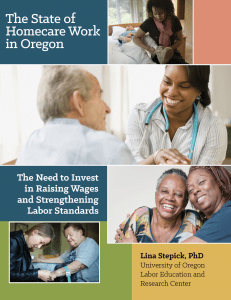New studies from the Labor Education and Research Center (LERC) at the University of Oregon with homecare workers in Oregon find the need to invest in strengthening labor standards and raising wages and that, under COVID-19, homecare workers are “essential yet invisible.”
 The first study, The State of Homecare Work in Oregon: The Need to Invest in Raising Wages and Strengthening Labor Standards, shows that Homecare work has one of the highest projected growth of any occupation. The homecare industry is growing rapidly while nonunion private agency homecare workers’ wages stagnate. In total, the median cost to clients of homecare in Oregon is $4,957/month. However, the median homecare worker monthly wage is $1,350. Long devalued, homecare workers exhibit skill and remarkable dedication in their profession. This study details how raising wages and standards in this industry is necessary to recruit and retain the skilled and dedicated workforce Oregon needs.
The first study, The State of Homecare Work in Oregon: The Need to Invest in Raising Wages and Strengthening Labor Standards, shows that Homecare work has one of the highest projected growth of any occupation. The homecare industry is growing rapidly while nonunion private agency homecare workers’ wages stagnate. In total, the median cost to clients of homecare in Oregon is $4,957/month. However, the median homecare worker monthly wage is $1,350. Long devalued, homecare workers exhibit skill and remarkable dedication in their profession. This study details how raising wages and standards in this industry is necessary to recruit and retain the skilled and dedicated workforce Oregon needs.
A second, follow-up LERC study with homecare workers in Oregon examines how COVID-19 has made already hazardous and complex work even more risky and challenging to navigate, as homecare workers often must figure out on their own how to adapt care routines and take on additional health and safety precautions at work. Because homecare work is primarily conducted by women and is one of the most racially and ethnically diverse professions nationally and in the state of Oregon, these new challenges disproportionately affect women and women of color specifically.
with homecare workers in Oregon examines how COVID-19 has made already hazardous and complex work even more risky and challenging to navigate, as homecare workers often must figure out on their own how to adapt care routines and take on additional health and safety precautions at work. Because homecare work is primarily conducted by women and is one of the most racially and ethnically diverse professions nationally and in the state of Oregon, these new challenges disproportionately affect women and women of color specifically.
Homecare workers expressed that, despite being classified as essential, they feel sacrificial and undervalued. Underpaid homecare workers are often paying for necessary supplies out of pocket and must navigate anxieties from both increasingly unstable hours and earnings and fear of contracting the infection while working.
